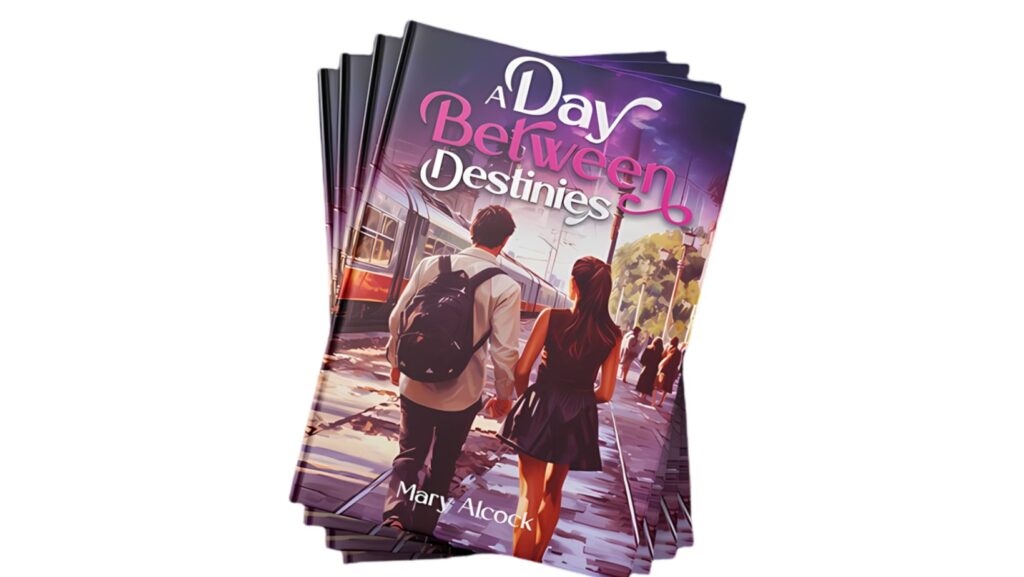
Have you ever wondered how one fleeting day could change everything? Imagine stepping off a train in a European city, catching someone’s gaze, sharing a laugh, then parting ways — and yet your heart knows that moment mattered. That’s the kind of gentle magic you’ll find in the romance book by Mary Alcock, A Day Between Destinies.
In this article, we’ll wander through the pages of this story, dive into its characters, setting, themes and why it resonates so warmly. Whether you’re a seasoned romance reader or someone looking for a tender, hopeful story, this book just might be your next favourite. And yes — we’ll even touch on serendipity meaning in love — because sometimes fate has a soft whisper rather than a loud trumpet.
1. Why this romance book by Mary Alcock stands out
So many romance novels promise sweeping gestures, dramatic declarations, or years-long sagas. But A Day Between Destinies takes a different path: it focuses on a single, unforgettable day, yet manages to feel like a lifetime of meaning tucked into hours. According to a review, the novel is described as “a tender, slow-burning romance set against the dreamy backdrop of Vienna”.
It stands out because it doesn’t rely on melodrama. It relies on authenticity — the kind of story where you might not shout “I love you!” at the top of your lungs, but you realize deep inside that your world has changed. In that sense, reading this book is like watching a butterfly emerge: quiet, delicate, yet transformative.
2. Meet the author: Mary Alcock’s style and voice
When I first encountered Mary Alcock’s writing, I felt as though I’d been handed a postcard from someone who has lived, loved and observed with gentle clarity. The author’s voice is warm, intimate, unhurried. On her website she writes: “Sometimes, it’s in these ordinary moments that we find the extraordinary.”
Her style invites you in like a friend sharing a memory. There’s no rush, no heavy artifice — just people, places, feelings. And as a reader, you feel safe but curious, you feel hopeful but grounded. That combination is rare, and it makes her work memorable.
3. The setting: Vienna and Paris as characters
Imagine wandering cobbled streets in Vienna, the glow of street lamps reflecting off old buildings. Imagine then wandering the Seine in Paris at dusk. These cities aren’t just backgrounds — they breathe in this story.
One reviewer noted: “Vienna isn’t just a backdrop, it’s alive… every detail adds atmosphere and texture.” The way Mary describes the setting, you feel the chill of a train station, taste the strudel shared on a bridge, hear the echo of footsteps in an art-filled gallery.
If characters in a novel are people you get to know, then a vivid setting is like another companion. And in A Day Between Destinies, the cities are companions, guiding the characters — and the reader — through that day.
4. The main characters: Luke and Isabelle
Let’s meet the two people at the heart of this story:
- Luke – A free-spirited writer, one reviewer says.
- Isabelle – A quiet literature student.
What’s powerful here is the contrast — and the meeting. The night the ice cream falls (yes, that’s a scene) they share a laugh, a moment of connection, and suddenly you care about what happens next.
Luke and Isabelle don’t begin as perfect, and the story doesn’t claim they will end perfect. They begin as people meeting, as people open to possibility. And that’s what makes them believable, and their connection meaningful.
5. Plot overview (without spoilers)
Here’s how the story flows — think of it like stepping onto a train of possibility:
- Two strangers meet on a train to Vienna.
- They spend one beautifully ordinary day exploring Vienna together, sharing laughter, stories, small fears, and glimpses of hope.
- They part ways — but fate isn’t finished. Paris beckons.
- The question becomes: Can something that began in a moment last through distance, uncertainty, and what-if?
In short: It’s a story of chance meetings, one day of connection, and then what happens afterwards. It feels like a ripple in water that turns into something larger.
6. Key themes: chance, connection and change
Let’s break down a few of the big ideas Mary Alcock invites us to ponder:
Chance and serendipity
The idea that sometimes things just happen — two people on the same train, the right seat, the right look. It speaks to serendipity meaning in love — the notion that love can arrive by accident, or by design we don’t fully control.
Connection in the moment
The characters don’t spend years together. They spend a day — and through that day they connect. It’s like a spark in the dark: brief, yet capable of lighting something inside. And Mary shows how meaningful those moments can be.
Change and what it reveals
A day can change you, the story suggests. Not always through grand speeches, but through small acts: a smile, a confession, a walk through a city you didn’t expect to feel so alive. The theme of change isn’t forced — it’s gentle, like the tide returning to shore.
The geography of the heart
With Vienna and Paris, the cities become metaphors. Vienna: elegance, reflection, maybe hesitation. Paris: hope, second chances, light. As the characters move through places, they also move inside themselves.
7. Writing style: how Mary invites you in
If I were to describe the writing style in one analogy: reading this book is like strolling through a garden at dusk. The path is lit, you move slowly, you notice the flowers, you hear the distant hum of the city. There’s no rush.
Mary Alcock uses straightforward language, yet infuses it with emotion. She uses personal pronouns like “you” in a way that reminds you — “Hey, this could be you.” She doesn’t hide feelings, but she doesn’t dramatize them either. The result: a style that feels both comfortable and vivid.
In a review, someone said: “What stood out most … was how Alcock made the setting an active part of the story.” That shows the balance — writing that is serene yet evocative.
8. Why you’ll feel like you’re travelling too
One special note: this book doesn’t just tell a romance story. It gives you a mini-escape. If you’ve ever dreamed of Vienna’s coffeehouses or Paris’ bridges, you’ll enjoy the travel-feel woven into the romance.

The journey isn’t just external (the train, the city, the cafés) — it’s internal, too (what it means to meet someone, how you respond to a moment). The combination of place + feeling = something immersive. If you love romance and travel in equal measure, this is a delightful match.
9. What the book says about love and timing
Romance often asks: “Is the timing right?” In this story, the answer is less about clock times and more about heart times. The characters don’t worry about careers or grand destinies — they simply meet, they feel, they explore possibility.
The novel suggests that love isn’t always about finding the perfect moment. It might be about catching the imperfect one, and choosing to explore it. The clock may tick, the train may depart, but the feeling remains. That’s a hopeful message.
10. Who this book is for — and who it’s not
Who it’s for:
- Readers who love character-driven stories over big plot twists.
- Fans of romance set in real, beautiful places who appreciate mood and atmosphere.
- People who believe in subtle emotional arcs rather than sweeping epics.
- Anyone looking for a short, impactful read (the story is described as being fairly concise).
Who it may not be for:
- Readers who prefer long sagas spanning decades with many plot arcs.
- Those seeking high-octane romance with dramatic revelations.
- Or readers who want fast pacing, high tension or lots of conflict.
If you like your romance gentle, introspective and set against evocative cities — you’ll likely love this book. If you want the opposite, you might find it too quiet.
11. Reader impressions: what people are saying
From what I gathered:
- One review said: “I wasn’t ready to say goodbye to either of them… It’s hopeful without being naïve, romantic without being cheesy.”
- On Goodreads, readers give it around 4.0 stars and mention the emotional connection and vivid setting.
- In the description, the book is pitched as “The Book Everyone Will Be Talking About in 2025.”
In short: the response is warm, thoughtful, and appreciative of its quieter strengths. Many say the characters linger in mind after finishing the book.
12. How to get the most from reading this book
Here are some simple tips to enhance your reading experience:
- Create the right ambience. Maybe brew a cup of coffee, dim the lights, imagine yourself in Vienna.
- Read slowly. This isn’t a rush-through type story. Let the scenes sink in.
- Reflect after each chapter. Pause and think: What did that moment feel like? What would I have said?
- Pay attention to the setting. The cities aren’t just decoration. They contribute meaning.
- Keep a notebook. Jot down sentences that hit you. That way, the book becomes more than reading—it becomes remembering.
By doing this, you’ll make the read more immersive and emotionally resonant.
13. Final thoughts: lasting impressions
In many ways, this book is like an unexpected train stop on a journey you didn’t plan—but are glad you took anyway.
Reading A Day Between Destinies by Mary Alcock is like finding a quiet bench in a beautiful garden and realizing you’ve been walking fast your whole life. You stop. You look. You feel. And you see that sometimes the simplest things—coffee in a café, a shared glance, a walk beside a river—are the gateways to something bigger.
Whether you believe in destiny or not, this story gently invites you to consider that maybe one day, one connection, one moment, can ripple outward and change everything. That’s the magic of love it shows us — not loud, not ostentatious, but present.
So if you’re looking for a romance book by Mary Alcock that’s elegant, heartfelt and set in beautiful places, this one deserves a place on your shelf.
FAQs
1. What is A Day Between Destinies about?
It’s a romance novel by Mary Alcock in which two strangers, Luke and Isabelle, meet on a train to Vienna, spend a meaningful day together, later reconnect in Paris, and explore whether a connection born in a moment can last.
2. Who are the main characters and what makes them special?
The main characters are Luke, a free-spirited writer, and Isabelle, a quiet literature student. Their specialness lies not in grand gestures, but in being present, real, and willing to let a moment unfold.
3. Does the story span many years or just a short time?
While much of the narrative centers around a single, unforgettable day, the emotional impact and the questions it raises stretch beyond that day — as the characters face distance, time, and possibility.
4. What makes the setting important in this book?
Vienna and Paris aren’t just places in the background—they shape the mood, reflect the characters’ inner states, and enhance the romance. Mary Alcock uses the setting almost as a character.
5. Is this book suitable for someone new to romance novels?
Yes. If you’re new to romance reading and prefer stories without heavy drama or many plot twists, this one is especially suitable. It’s more about emotion, connection and atmosphere than high-stakes suspense.
